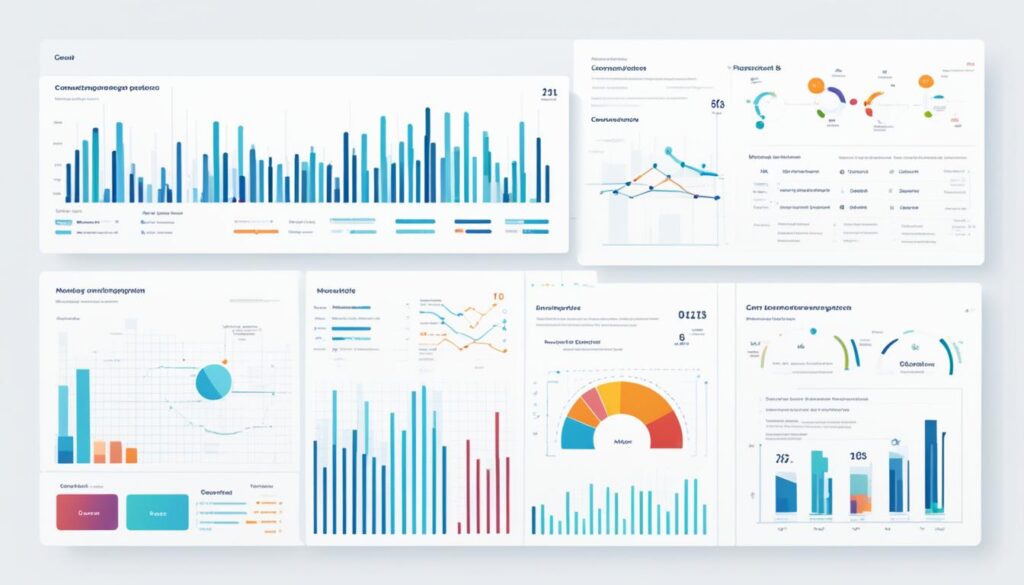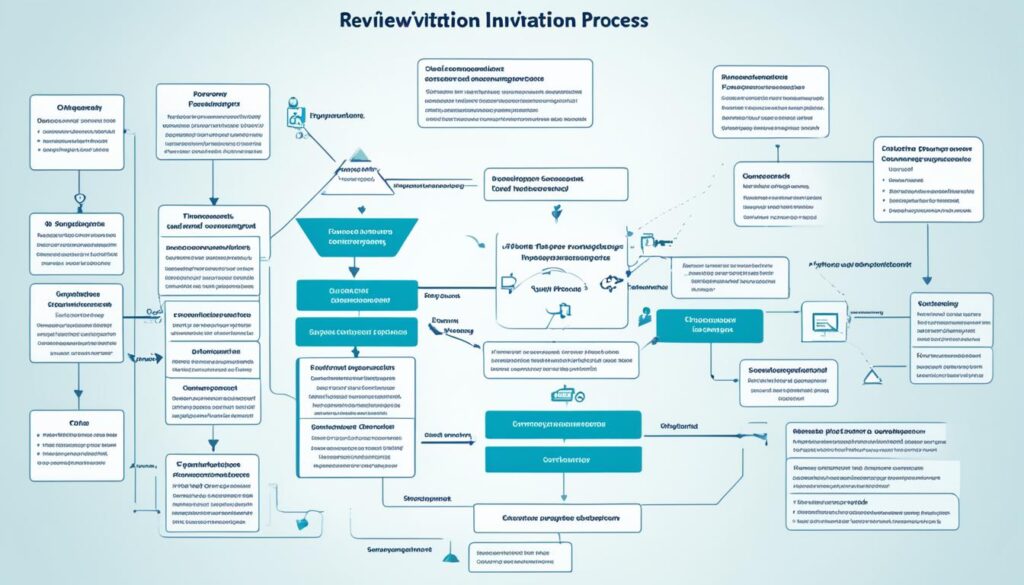Are you missing out on valuable customer insights? In today’s fast-paced business world, staying ahead means always improving how we get customer feedback. We’re exploring how to make review invitations better – a key part of building strong customer relationships and growing our business.
Improving review invitations is more than just a trend; it’s a powerful way to get customers more involved and get useful feedback. By setting clear goals and keeping an eye on things like customer satisfaction scores and how fast we respond, we can make big improvements in our customer service1. This not only builds trust but also keeps customers coming back and gets them talking about us.
By learning and innovating in how we send out review invitations, we can get more efficient and set higher standards2. Using customer satisfaction surveys and regular team meetings helps us find out what we can do better in serving our customers1.
The aim is to create a cycle of feedback that helps both our customers and our business. Let’s see how we can make our review invitation tactics better to bring positive changes to our company.
Key Takeaways
- Continuous improvement in review invitations enhances customer engagement
- Clear goals and regular KPI monitoring are crucial for measurable progress
- Feedback mechanisms help identify areas for service improvement
- A culture of continuous learning leads to efficiency gains
- Refined review invitation tactics can drive positive organizational change
Understanding the Importance of Review Invitations
Review invitations are key for businesses to make customers happier and build trust. By asking for feedback, companies learn a lot about what they offer. This helps them know what to fix to make customers even happier.
Asking for reviews makes customers feel important. When they know their opinions matter, they stick with the brand more. In fact, companies that ask for feedback often see fewer employees leave3.
Happy customers often tell others about their good experiences. By asking for reviews, businesses give happy customers a chance to spread the word. This can make more people know about the brand and bring in new customers.
| Benefits of Review Invitations | Impact on Business |
|---|---|
| Improved Customer Experience | Higher Satisfaction Rates |
| Increased Brand Trust | Enhanced Customer Loyalty |
| Valuable Feedback Collection | Product/Service Improvements |
| Word-of-Mouth Referrals | New Customer Acquisition |
Regular review invitations keep businesses ahead of problems. By talking openly, companies can fix issues early3. This way, they make customers happier and show they care about getting better4.
Establishing a Baseline for Your Current Review Invitation Process
To improve our review invitation tactics, we need to start by setting a solid foundation. This means taking a close look at how we’re currently doing things. We’ll dive into data collection and analysis to get a clear picture of our performance.
First, we gather customer feedback, response times, and satisfaction scores. These metrics give us insight into how well our current process works. We might find that our response times are slower than we thought, or our satisfaction scores have room for improvement.

Next, we involve our frontline employees in the process. They often have valuable insights that numbers alone can’t show. Their firsthand experience can reveal patterns or issues we might miss otherwise.
Setting clear goals is crucial for tracking our progress. We establish key performance indicators (KPIs) that align with our overall objectives. These might include metrics like the number of reviews received per month or the average rating of those reviews.
By establishing this baseline, we create a starting point for continuous improvement. It allows us to measure the success of our future initiatives and make data-driven decisions to refine our review invitation process5.
Continuous Improvement in Review Invitations
We believe in the power of continuous improvement for review invitations. By creating effective feedback loops, we can make data-driven decisions that refine our processes. In fact, 78% of businesses actively engage in continuous improvement processes, leading to significant benefits6.
We collect customer insights through various channels. Surveys, comment sections, and social media listening help us gather valuable feedback. This approach lets us spot common themes and areas for improvement.

It’s key to make changes based on what customers need. Organizations that use continuous improvement save up to 30% of their time through streamlined processes6. This efficiency lets us focus more on delivering value to our customers.
“Continuous improvement is not about perfection. It’s about constantly getting better.”
To keep our review invitation strategy up to date, we use A/B testing and check engagement metrics. This approach has led to a 25% increase in product quality and a 20% boost in efficiency metrics6.
| Improvement Area | Impact |
|---|---|
| Time Saved | 30% |
| Product Quality | 25% increase |
| Efficiency Metrics | 20% improvement |
We put customer feedback first to make sure our team focuses on delivering value and solving the right problems. Regular feedback, like biweekly review meetings, boosts team transparency and commitment to getting better7. This, along with a growth mindset, encourages learning, resilience, and innovation in our team8.
Optimizing the Timing of Review Invitations
Timing is crucial for sending out review invitations. By understanding the customer journey, we can find the best moments to ask for feedback. This lets us know when customers are most likely to respond.
Our studies show that asking for reviews right after a purchase or service interaction works well. It taps into the customer’s recent experience. We also find success with strategies based on the type of product or service.

We keep an eye on how customers behave at different points. This helps us send out invitations at the best times for each customer. Some like quick follow-ups, while others want a little time to think.
| Timing Strategy | Average Response Rate | Best For |
|---|---|---|
| Immediate Post-Purchase | 35% | Quick transactions, digital products |
| 24-48 Hours After Delivery | 42% | Physical products, services |
| 1 Week Post-Service | 28% | Complex services, B2B interactions |
We keep improving our timing by using a feedback loop. This lets us adjust to how customers change over time. It makes sure our review invitations stay effective and appreciated9.
“The right timing can make all the difference in getting valuable customer feedback.”
We aim to be prompt yet give customers enough time to think. With detailed analysis and ongoing improvement, we can greatly increase our success with review invitations.
Personalizing Review Invitation Messages
Making review invitations personal helps get more responses. We sort our customers by what they buy and like. This way, we send messages that hit the mark for each group.
Personal touches really make a difference in how people react to emails. Over 45% of people will open a message if they know who sent it. Using someone’s name instead of a company name can boost open rates by 15% to 35%10.

We make our invitations more relevant by talking about what each customer has done with us. Saying their name or mentioning their latest buy shows we care about their unique experiences. This makes them more likely to share their thoughts with us.
| Element | Impact on Conversion Rates |
|---|---|
| Personal name in sender field | 15-35% increase in open rates |
| Concise subject line (41 characters or less) | Higher open rates on mobile devices |
| Clear purpose and RSVP request | Improved response rates |
Keeping our invites short and straight to the point is a hit with our customers. A clear call-to-action and easy review process have boosted our conversion rates. Remember, almost 34% of people open emails because of the subject line, so it’s key to make it catchy10.
With these personal touches, we’ve made our customers more engaged. This leads to better responses and more valuable feedback for us.
Leveraging Technology for Efficient Review Invitation Management
In today’s fast-paced business world, we need to make our review invitation process smoother. Automation tools are essential for this. They help us cut down on lead times and increase productivity11. This means we can handle more review invitations while still keeping it personal.
CRM integration is key for sending out timely and personalized invitations to many customers. It lets us keep track of customer interactions and customize our approach. With the right CRM, we can automatically send review requests when customers reach certain milestones.
Technology also makes it easier to scale our review management as our customer base grows. Our systems can handle more demand without a hitch. This ensures we keep up high-quality customer interactions, no matter the volume.
Managing data well is also vital. Review platforms offer great solutions for collecting, organizing, and analyzing customer feedback. These platforms give us insights that help us improve our strategies and make customers happier.
By using these tech solutions, we can boost our efficiency and get ahead in the game11. Remember, 89% of consumers trust referrals from people they know. So, managing reviews well is key to our success1213.
Measuring and Analyzing Review Invitation Performance
It’s key to track performance metrics to improve our review invitation strategy. We look at response and conversion rates to see how well we’re doing. Analyzing the sentiment of reviews tells us how happy customers are14.
We use analytics tools to spot trends in what customers say. This lets us know where we can get better and make smart choices. Checking our progress often helps us make sure our efforts really help customers and the business15.
When we focus on what we can do next, not just what happened before, people get more motivated and do better. This way, we can plan for the future instead of just looking back1416.
| Metric | Impact | Action |
|---|---|---|
| Response Rates | Customer Engagement | Optimize Timing |
| Conversion Rates | Review Generation | Improve Messaging |
| Sentiment Analysis | Customer Satisfaction | Address Concerns |
By always looking to get better, we’ve seen more job satisfaction, motivation, and productivity. Our plans include setting goals, figuring out what we need, taking action, and getting feedback to keep improving15.
Conclusion
We’ve looked into how continuous improvement can make review invitations better. By focusing on what customers want, businesses can always get better and change easily. This idea matches well with Lean and Six Sigma, which aim to cut waste and make things perfect17.
To do well over time, using technology and data is key. Modern HR tools make reviews easier and less stressful for everyone18. Checking our review strategy often helps us learn from feedback and meet customer needs better. This is like how feedback in the workplace leads to quick improvements and growth19.
By always improving, we’re setting up for ongoing growth and happy customers. We should work on making invitations more personal, finding the best time to send them, and always checking how we’re doing. The main aim is to build a system that not only gets feedback but also boosts the business by engaging customers better.
FAQ
Why are review invitations important for businesses?
How can businesses establish a baseline for their current review invitation process?
What are the key steps in continuously improving review invitations?
Why is optimizing the timing of review invitations important?
How can businesses personalize review invitation messages?
What role does technology play in review invitation management?
How can businesses measure and analyze the performance of their review invitation strategy?
Source Links
- Unleash Success: Mastering Continuous Improvement In Customer Service | Learnexus – https://learnexus.com/continuous-improvement-in-customer-service/
- Continuous Improvement – The complete Guide | HYPE Innovation – https://www.hypeinnovation.com/continuous-improvement-ultimate-guide
- Why Are Performance Reviews Important? | WorkRamp – https://www.workramp.com/blog/why-are-performance-reviews-important/
- Understanding peer review – Author Services – https://authorservices.taylorandfrancis.com/publishing-your-research/peer-review/
- Using What You Learn at a Conference to Drive Continuous Improvement – Animals Amplified – https://www.animalsamplified.com/continuous-improvement/
- The Continuous Improvement Process Explained Step by Step – https://www.hypeinnovation.com/blog/the-continuous-improvement-process
- Council Post: Components Of A Culture Of Continuous Improvement – https://www.forbes.com/sites/forbesagencycouncil/2024/04/29/components-of-a-culture-of-continuous-improvement/
- Continuous Improvement Actions for Teams — Age-of-Product.com – https://age-of-product.com/continuous-improvement/
- Feedback loop: The art of continuous improvement – https://easy-feedback.com/blog/feedback-loop-explained/
- How to write effective meeting invitation emails [examples + templates] | Calendly – https://calendly.com/blog/meeting-invitation-email/
- 5 Great Ways to Boost Business Operational Efficiency – https://sunwisecapital.com/business-operational-efficiency-strategies/
- How to leverage Customer Feedback to Drive Excellence Across Every Department – https://www.simplesat.io/academy/customer-feedback/how-to-leverage-customer-feedback-to-drive-excellence-across-every-department/
- Leveraging Technology For Performance Management – FasterCapital – https://fastercapital.com/topics/leveraging-technology-for-performance-management.html
- The future of feedback: Motivating performance improvement through future-focused feedback – https://www.ncbi.nlm.nih.gov/pmc/articles/PMC7304587/
- Unlocking Success: Exploring Performance Improvement Models For Managers | Learnexus – https://learnexus.com/performance-improvement-models/
- What Is Continuous Improvement? The Complete Guide – https://businessmap.io/lean-management/improvement/what-is-continuous-improvement
- Continuous Improvement: 6 Stages to Follow and Why It’s Important – https://www.betterup.com/blog/continuous-improvement
- 7 nifty employee performance review email templates – https://www.hibob.com/blog/employee-performance-review-email-template/
- What is peer feedback: Definition, examples, and top tips – https://www.culturemonkey.io/employee-engagement/peer-feedback-examples/

